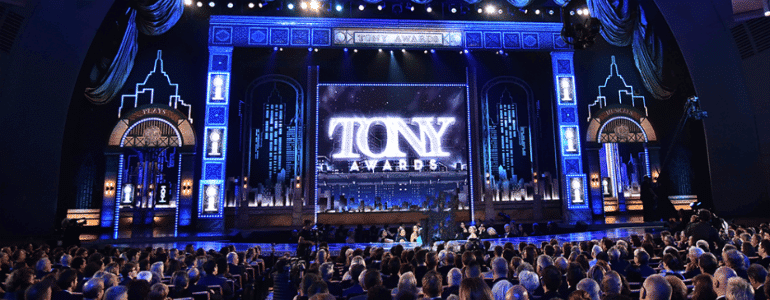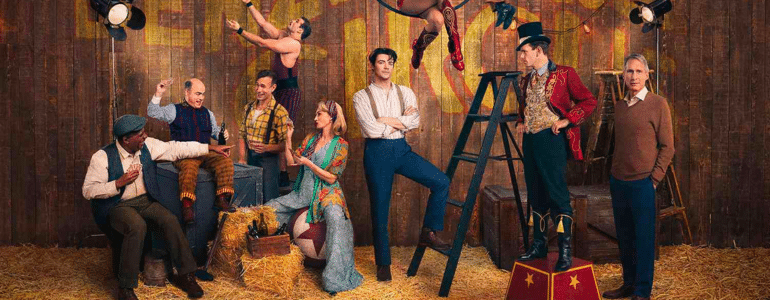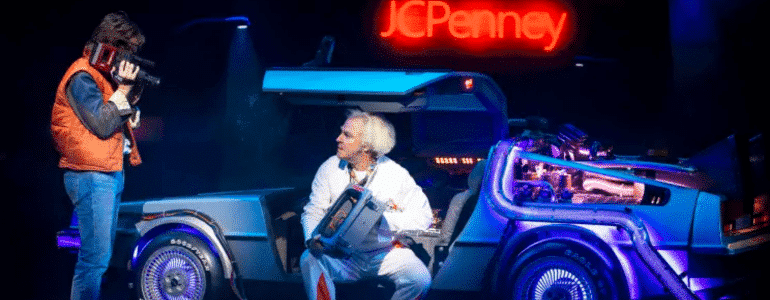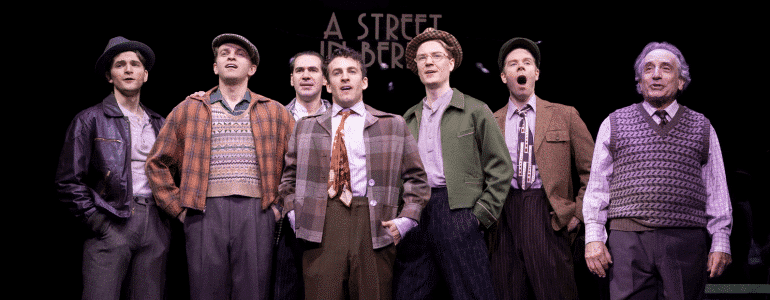Episode 3 Transcript – Nina Lannan
Ken: Hello everyone. Welcome to The Producer’s Perspective Podcast, episode number three. First of all, I want to thank everyone for the fantastic feedback – keep those comments coming. If there are any folks out there that you want to hear from on future podcasts do let me know, send me an e-mail and we’ll try to line them up. However, on today’s podcast, I’m thrilled to be sitting across from one of the people in the industry who I admire the most. Someone who I’ve had the pleasure of working with when I was a company manager both on Thoroughly Modern Millie and the Gypsy revival starring Bernadette Peters. I’m talking about Nina Lannan, the founder of the Broadway general management firm Bespoke Theatricals, which is one of the general management powerhouses on Broadway. She and her office have general managed some of Broadway’s biggest shows including all the way back to Cats, Mamma Mia!, Billy Elliot, Evita, Rocky, The Color Purple, Motown, Legally Blonde, 9 to 5, the upcoming School of Rock and so on and so forth. If you want to see a long list of credits, go to IBDB, it just scrolls on and on forever. In addition, she was the chair of the Broadway League for two years and was the first woman to occupy that position in the league’s 80 year history. In 2009, Crain’s Business named her one of the 50 most powerful women in New York and, in my opinion, she also has the distinct reputation of being one of the classiest women on Broadway. Welcome, Nina!
Nina: Thank you. Thank you, Ken. I’m delighted to be with you guys today.
Ken: First, can you just, in your own words, describe to me what a general manager’s role is on a Broadway show?
Nina: A general manager, I think, has the best job on Broadway. It’s the most fun because we work with everybody who works on a Broadway show and we connect to everyone. And basically anyone can be a producer – they have to have a project and they have to raise the money to do it. If a producer wants to do just that and turn the show over to us we will run the rest of it – we will do the budgets for the show, we will negotiate all of the contracts for the show, we will hire everyone, we will make certain that all of the departments on the show are engaged, that they have everything they need to get their work done, and by departments I mean the casting department, the scenic design department, the costume design department, the technical department. We make certain all of these areas of the show are staffed appropriately and then we work with them to coordinate a schedule to bring the 200-odd people who are working on a Broadway show to reach a common goal when we have our first show.
Ken: You’ve obviously worked on Broadway over the last two or three decades, all the way back from Cats until now. How has the role of the general manager shifted over the past few decades? Do you see any change or is it the same thing as when you started?
Nina: What has happened is so much more is being done now with marketing and with dynamic ticket pricing. All of that didn’t happen two or three decades ago, so I find that the general manager’s job is being taken up more and more with those areas. We can be sitting in many different meetings on marketing, such as dealing with social media, dealing with the roll out of how we’re going to price a show, reviewing what is actually happening with ticket sales. We have so much more data in these areas than we had previously and it requires maintenance and it requires reviewing that data. It’s no good to produce data and not look at it. In the old days, let’s say in the ‘80s, and even into the early ‘90s, the general manager was much more involved with designers and with the technical personnel and the development of the show. I really feel that a lot of the design process and the technical process is being left to the production managers of a show. I even had Natasha Katz, the lighting designer, ask me last year, “Nina, why don’t we see general managers in more of our production meetings?” and I said that’s because we’re taken up and we’re busy in these other marketing meetings. I said, “I like sitting with all of you guys, this is where all the creative stuff really happens.” But unfortunately there are just so many hours in the day and we can’t fit in as many of those meetings as we’d like to.
Ken: So you prefer a little bit of a throwback? Would you prefer to go back into the past a bit?
Nina: Yes. What’s happened in the industry over the last several years is there’s also many more people working in the industry. It’s not as simple as it was and the more people you have working on a show, the more need there is for administration and coordination of those people. If there are 30 people working on a show, it’s not that hard. If there are 300, it’s much harder, and that really falls to the general management office to coordinate the activities of all of those people.
Ken: It’s funny you talk about being involved, because that’s something I remember about working with you on Gypsy, you really getting into the nitty-gritty of the design and making sure that set would not only function but that we could also afford it.
Nina: Well that’s part of my history. I started working on Cats and in 1982 when it opened it was the most expensive show on Broadway and very complicated, scenically. We had many different shops working on it and they all had to be coordinated so at a very early age I became involved in the process of trying to understand the problems with the set. I also did Sunset Boulevard for the Really Useful Company, Andrew Lloyd Webber’s company, in the ‘90s and that, again, was $13 million at that time, which was an unbelievable amount of money – at that time. It, again, involved items being constructed up in Canada, costumes being made in Switzerland, in Italy, in England, so there was an enormous amount of coordination in that so it was just necessary to get involved in the physical production to that extent because that’s where the largest amount of dollars was being spent.
Ken: So $13 million for Sunset Boulevard in the ‘90s and Cats, how much was that?
Nina: Cats was capitalized at $3.9 million and it actually cost $5.2 million. I was actually discussing this with Bob Wankel of the Shubert Organization yesterday – we never got any more money than the $3.9 million. I remember a stack of bills about two feet high on the company manager’s desk and the show was making money each week so every week three or four more bills got paid and all of those vendors just waited patiently, because everyone knew we were working on a hit, for their bill to get paid and it took about two months to pay all of the bills on that show.
Ken: So even Cats, what we think of now as this monstrous success, which obviously it was, took a little bit of time to get everybody paid at the beginning of that run.
Nina: Well yes, but that was primarily because John Napier came to Bernie Jacobs and said, “I have this great idea for the set, this back wall that flips down onto the stage, and I want to do it.” That’s a producer’s decision for you. Bernie said, “Alright, go ahead and do it,” even though we had no money in the budget for it. That, to me, is what a producer does. As a manager I could never make that kind of decision but a producer can come in and take a look at a show and say, “No, it’s worth it. I know the show is going to be a hit and so I want to do this.” The same thing happened to a lesser extent when I worked on Annie Get Your Gun with Barry Weissler. He waited four months for Reba McEntire to be able to come into the show and we cast the show with interim people in our lead role. We had practically no money at that point, I mean it would have been wise to just close the show and be happy with the money we had made, but he hung on and we all buckled up and tried to keep our expenses as low as possible and in the end Barry was right. Reba came into the show, it was a huge hit, it made money and helped support some of the losses we had before that.
Ken: So what do you think Cats would cost today?
Nina: Well, funny you ask me that, because there is talk of a revival of Cats and I’m going to sit down next week, dust off my old production books and work on a new budget for Cats. What’s fascinating in the intervening years is, for example, on the productions that have occurred in Asia and in Europe and in London right now, where it’s a huge success on the West End, the unitards, for example, are photocopied in China. In the old days they were hand painted; now they can be photocopied. With 3D printing right now, I could print 3D printed props in this conference room right here. So I’m hoping that will help us a bit too, the whole 3D printing aspect, which I think will be a fascinating thing to get into and, again, that’s what fascinates me. I’m fascinated to see if 3D printing can help making the three times life-size props easier and cheaper for us.
Ken: You talked a little bit about your beginnings on Cats. How did you end up as a general manager? What was your path? Everyone I talk to seems to have a different path, what was yours?
Nina: Like many people I graduated from the University of California at Berkeley, I was a stage manager, I stage managed a bit for ACT and San Francisco Opera and then decided to move to New York because this is where the center of theater was. I had no idea what a general manager did but when I interviewed at a very prominent general management firm I figured if it didn’t work out, these were the folks who hired stage managers so they would hire me as a stage manager. It obviously did work out. I worked for them for thirteen years, until one of the partners died, and then opened my own office.
Ken: And along the way, any great advice that you got, as you were coming up early in your career, that you still remember to this day? Any mentors say to you, “Kid, this is what you should do. This is what you should remember to work on Broadway”?
Nina: Well Tyler and Peter, who were the partners I worked for, Tyler Gatchell and Peter Neufeld, were incredibly supportive and they created a good home in their office and they also exposed everyone in their office to the history of theater. I remember they took everybody in the office out to various benefits and really included them in the entire theatrical community and tried to introduce them to the theatrical community so I tried to emulate that in the office that I have set up. I remember that very carefully. There was a wonderful production supervisor, Peter Feller, who always said, “Don’t be the victim,” and that has stuck with me in many ways and I tell that sometimes to young managers who are sometimes just too ready to apologize for their actions when something goes wrong, and I think don’t give other people a stick to beat you with – don’t do that. You can apologize if there was a mistake but don’t over apologize or just acknowledge a mistake and say, “I’m going to make this right and I’m going to move forward.” If you start going around, beating yourself up, someone else is going to beat you up, so don’t do that.
Ken: That’s great advice. If you could do it over again, is there anything about your training you’d do differently? Or another way to phrase this question is what do you think is the best training for someone who says, “I want to be a general manager”?
Nina: I would say to anyone coming in, put yourself in the place with the most energy and the most excitement and the most activity. The only regret I had is perhaps right out of college I should have come to New York and not worked at ACT and San Francisco Opera, although I loved my experiences there, because I do think people coming out of school have an enormous amount of energy and it’s seductive and it’s interesting and, I think, incredibly appealing to would-be employers, so I think those folks should just put themselves in front of work. I do tell people when they meet with me, try not to just work in an office with just one person, unless you really like that person or you’re doing it as a short term job, because you don’t want to be just sitting in an office answering the phones or doing correspondence for somebody unless that person is really, really a genius or there’s some extenuating circumstance. Get yourself in a position where you can just bump into as many people as possible. As many people have said to me, and some designers when I hired them, they say, “I just want to be in an interesting room. I want to be in a room with interesting people. No matter what happens, if the outcome is good or bad or whatever, it’s going to be interesting and I want to be with those people,” and I think that’s what you have to think about in this business, because it is a collaborative business and it’s all about working with people. We work with people on one show and we work with a different assortment of those same people on another show, or half of those people again on another show. So it’s about being in touch with all of these creative people we have in our business.
Ken: You obviously do lots of different types of shows – straight plays, revivals, musicals – but it does seem to me that this office over the years has been the go-to office for big musicials that start in London and then come over here. Obviously Mamma Mia!, Billy Elliot, Ghost came over, Dirty Dancing, which didn’t come to Broadway but toured. I’m still trying to figure out what works in London versus what works here. What do you think it takes for a show to work on both sides of the pond?
Nina: That’s an interesting question. Certainly we all understand that the financial parameters of London are quite different than here, so you have more leeway in London. Generally, I think, if something really works in London, it’s going to really work here. If something only works in London because the costs are cheaper or the structure is different or it’s very specifically English then, no, it’s probably not going to work here. I think shows can run longer in London than they can here and our competition seems somewhat stronger here, the competition with other shows and selling tickets, in our structure here. So I don’t have an answer for that.
Ken: What do you think the differences are between a West End producer and a Broadway producer? Anything we can learn from them? Stylistically, how are they different?
Nina: I think it’s much more of a club and more chummy over in the West End. There is a group of people who have been a part of the business for a very long time and they will always be part of the business. Here, I think we have a lot more business people investing in shows, trying to produce shows – people who have made money in other disciplines and are coming to Broadway to either make money or lose money.
Ken: One of the reasons I started out with a management career is because I wanted to learn the business side of Broadway before I started producing. It seemed like a natural way to learn all of the aspects of it. Have you ever wanted to produce?
Nina: I have thought of a couple of shows but what I like and what I said at the beginning of this interview is working with all of these different people in this business. I love all of the people backstage, I love talking to prop people, wig people, so that’s really where my passion is, is really trying to help all of them work better, trying to make every department on a show work better. The times I have moved more into producing, it’s kind of a different energy. It requires, for example, longer meetings and longer conversations. I doubt, in this office, that we write anything longer than two pages, at the most, because we’re typically spending the day answering questions and answering e-mails and just trying to get other people moving forward, so it is a different kind of energy and to do both at the same time, I think, is very difficult.
Ken: So Broadway, over the years, has been called the fabulous invalid, yet last week we had this record setting week – attendance is up, grosses are up, we have shows grossing near $3 million. If you were a doctor and Broadway was the patient, how would you describe its health right now? Great, stable, critical condition? Where do you think we are right now?
Nina: I suppose I would have to say stable. We can never, in a way, be a growth industry because we have a limited number of theaters on Broadway that we have to fit the shows into. What is worrisome now is, with the advent of premium ticket pricing, what has become the norm, like the news, as you refer to, last week, of $1.5, $1.6, $1.8 million grosses. So a show that might be doing 90% capacity but not pulling in a lot of premium tickets, doing $700-800,000, is almost seen as a loser show, which is kind of bad, when we say that a show is doing 80% of capacity but selling normal priced tickets isn’t in the top 10 or 20 shows, so that’s kind of a worrisome development because I think Broadway should be a place where all types of people can come and see all different types of shows, but if we are looking for shows that are grossing in the $1.5-1.6 million area, you are obviously looking for musicals or plays with stars.
Ken: So what do you think if, again, you’re the doctor and we’re stable and you want to get us a little healthier? Any prescription you would give us? How would we combat that specific issue?
Nina: What’s frustrating sometimes is the production cost for getting a show up, and particularly advertising a new show, is so high that to do limited runs is really tricky. What if I had a really nice show with no star in it and I wanted to do a 12 week run on Broadway? Let’s assume I could put it in a theater. It would almost be impossible to do, as you yourself know, having done limited runs of plays, even with stars. When a producer comes to us and we do budgets and we say, “Alright, if we sell 100% of our tickets you might recoup 120% of your investment in 16 weeks.” That doesn’t look all that great. So I wish there was a way would could have more turnover of shows on Broadway – do more limited runs and it wouldn’t cost so much to launch a show on Broadway. I suppose when I say I would like to see more shows coming and going, we do have a lot of long running musicals that some people would say clog up some of our theaters. But those investors, they have a right to make as much money as they can from their shows.
Ken: That’s something that I’ve written about extensively. We’ve gotten so much better at keeping our shows going. The mega, decades-long running show didn’t exist before Cats and Les Mis and now it does. You’ve worked with a lot of producers, obviously, in the 50-100 shows you’ve worked on. I won’t ask you on the record who your favorites are but what characteristics do you think the best producers share?
Nina: I think the characteristics they share is that they’re very clear about the work that they want to do and the work that they want the general manager to do and where they want to give input. It’s nice for us to understand early on whether a producer wants us to just move ahead with all of the contracting in a show, maybe the producer just wants to concentrate on the advertising, some producers don’t want anything to do with the physical production of their show and it’s nice for that to be clear right at the beginning and it’s nice not to be second guessed with that. The hardest for us is when we work on a show with three or four active producers and they haven’t really selected a lead producer so we have to run all of the decisions by three or four or more people. That is very difficult because we do sometimes make decisions quickly in our business and particularly in the last four weeks before a show opens you are making hundreds of decisions daily and you need a quick turnaround.
Ken: Broadway needs to move faster, in my opinion, on all of those things and more and more, with not only lead producers now, but the multitude of above the title producers, things do tend to move a little slowly at times.
Nina: That’s what I said, just even on the general management side, coordinating all of the people that work on the show. You used to have an ad agency with one accounting exec, you used to have just one press agent that you had to deal with. Now, not only does everyone have an assistant, but then there are many people in all those different areas – in marketing, in social media, in online buying, in media buying, TV buying, whatever. Now, when you go to an ad meeting, even from the ad agency side, you used to only have three people there, let’s say – a creative person, your account exec and an executive at the ad agency. Now there are at least 13-15 people in the room.
Ken: Our first podcast was with Rick Miramontez who, famously, last year, touched every single nominee for best musical – he worked on all of them – and sometimes, I’m sure, I think this season, even, you are asked to work on shows that may be considered competing against each other, or at least for a Tony. How do you deal with conflicts in the industry like that?
Nina: Well everyone says if you’re at all successful in this industry, you’re conflicted. Everyone’s conflicted in this industry but we usually separate it on a practical level. In the office we usually separate it between people working on a show – people working on one musical that’s going to open in the season aren’t working on the other musical that’s opening in the season. I think plays and musicals have very separate audiences. I don’t think our audience for, let’s say, The Audience is the Motown audience, for example. I think they are totally different audiences. We basically focus on each show. I look at each show individually and we work very hard to just sell as many tickets as we can for that show.
Ken: What do you think the best training ground is for someone who comes to your office and says, “Nina, I want to be a producer? You’re an executive producer, you’re a general manager, you’ve worked with all of these people, I don’t have a billion dollars in the bank, I didn’t make a lot of money in a different industry but I want to be successful.” Some people say the days of the David Merricks, one person coming up though the business, are over. What kind of advice would you give to someone?
Nina: I think what you did, starting out in a management positon, and then moving into producing, is a good idea. I also see that Roy Furman has done a wonderful job of taking some young producers under his wing, allowing them to come into some shows that he’s worked on for a nominal investment and allowing them to participate in all of the advertising meetings and be around production as much as possible, so I think that’s one way to get into the pipeline of producing as well. I’m working with an actor and a choreographer now who have banded together and formed a producing group and invested in a couple of shows on Broadway. I think it’s great, actually, for anyone in the industry to start looking at producing and management because I think it opens up your eyes, basically, to the struggles we in the general management trenches feel and go through every day.
Ken: That is true, for sure. Okay, last question. I want you to imagine the genie from Aladdin shows up at your door and says, “Nina Lannan, I’m going to grant you one wish – you can change anything you want about Broadway.” Anything, one wish to change something overnight. What’s the one thing you would change?
Nina: Off the top of my head, without taking too much time, I would say one of my goals for Broadway, and I would like the genie’s help in doing it, is to increase the diversity of the folks we have working backstage in our theater and also onstage. I think it’s very important that the people we have working in this industry, we cast a footprint far larger than the actual business we do. I mean people around the world look at Broadway, and I think we should have more people of color on our stages and I think we should have more people of color working backstage.
Ken: A lot of people would argue that that would help translate to more people of color in the audience.
Nina: Yes, it would, it’s just obvious. I could always see that working on shows like Flower Drum Song, when I worked in the Equity building, you could just tell, and with Jelly’s Last Jam, when my office was also in the Equity building, the building was flooded then with actors of different ethnicities when those shows were happening and it was fantastic to see that. I don’t think we do a good enough job at that on Broadway right now.
Ken: It’s a great goal for all of us working on Broadway. I want to thank Nina for taking time from her incredibly busy day to speak with us. That’s it for episode three of the Producer’s Perspective Podcast. Next week’s guest will be non-other than Tony Award-winning playwright Terrence McNally, so make sure you subscribe so you don’t miss it. Until then…
Podcasting
Ken created one of the first Broadway podcasts, recording over 250 episodes over 7 years. It features interviews with A-listers in the theater about how they “made it”, including 2 Pulitzer Prize Winners, 7 Academy Award Winners and 76 Tony Award winners. Notable guests include Pasek & Paul, Kenny Leon, Lynn Ahrens and more.














